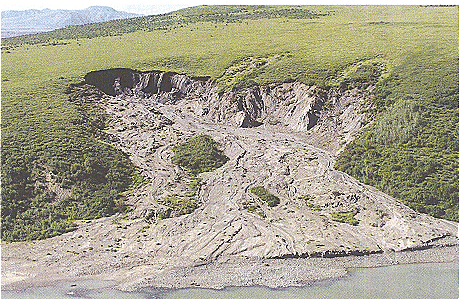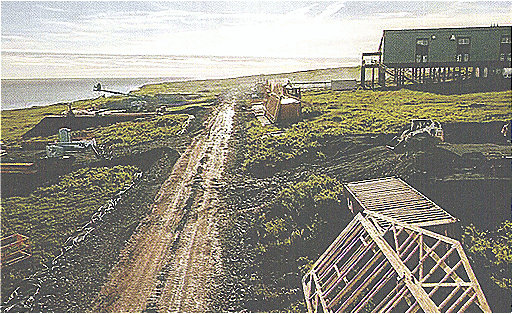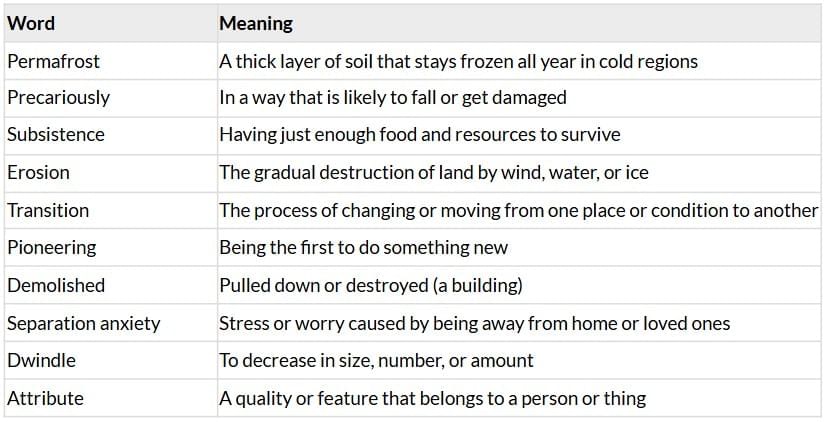Melting Ice in Alaska Chapter Notes | Gul Mohar Class 8: Book Solutions, Summaries & Worksheets PDF Download
| Table of contents |

|
| About the Author |

|
| Detailed Summary |

|
| Moral / Message |

|
| Character Sketches |

|
| Vocabulary Table |

|
About the Author
Craig Welch is an environmental writer with National Geographic. He has been a journalist for more than twenty years. His work has appeared in well-known publications like Smithsonian Magazine, The Washington Post, and Newsweek. He mainly writes about nature, climate change, and how people are affected by them.
Detailed Summary
The lesson “Melting Ice in Alaska” explains the dangers of global warming in Alaska, especially for the Yup’ik people of Newtok, a small village near the Ninglick River.
Because of climate change, the permafrost—a layer of permanently frozen soil—is melting. This thawing weakens the land, making the ground sink and collapse. Houses and fuel tanks are tilting, community landfills have washed away, and many homes have had to be demolished because they were unsafe. Erosion caused by rising seas and stronger storms eats away at the riverbanks, sometimes as much as 83 feet per year. Floods often leave families isolated, and studies warn that much of Newtok may be swallowed by the river as early as 2027.
A Big Thaw
This section explains the science behind the crisis. For thousands of years, the Yup’ik were nomadic hunters, depending on seals, moose, musk oxen, berries, and wild plants. They settled permanently in Newtok in 1949 and maintained a subsistence lifestyle, living off nature instead of industries. But as the planet warms, frozen soil is thawing across nine million square miles of the far north. This not only weakens buildings, roads, and pipelines but also releases greenhouse gases, which in turn make the Earth even warmer.
At the same time, sea ice is melting and moving farther from shore. This allows storm surges to travel inland, gnawing at the land and splashing into communities. Rising seas accelerate erosion, forcing the Yup’ik and other Alaskan villages to think about moving.
Moving to Mertarvik
To survive, the community began relocating to Mertarvik, a new village on higher ground. The move, however, is slow and difficult. Only a few families have shifted so far, while many remain in Newtok. Both villages are operating at the same time, making schooling and governance complicated.
In Mertarvik, new energy-efficient homes, a school, a community center, a water treatment plant, and a power station are being built. Yet only about one-third of the required homes are ready, and water and sewer systems are still incomplete.
Mixed Emotions
The relocation has created mixed feelings. Leaders like Andrew John see it as a necessary change for safety and survival. School officials like Dixon worry about children being divided between two communities. Young people like Martha Kasaiuli express sadness in poems about leaving their ancestral land, even though they know the move is important for the future.
In the end, the lesson shows how climate change is not only about melting ice but also about human lives, culture, and identity. The people of Newtok remind us that adaptability and unity are the keys to survival.
Moral / Message
The chapter teaches us that climate change is not just about the environment—it deeply affects people’s homes, health, and culture. It shows the importance of protecting nature and preparing for change with courage. It also tells us that human strength lies in adaptability and unity, even in difficult times.
Character Sketches
Yup’ik Community
The Yup’ik people are strong, traditional, and closely connected to nature. They rely on hunting and gathering for survival. Even though they are sad to leave their ancestral home, they are brave and hopeful, adapting to change for the safety of future generations.
Martha Kasaiuli
Martha is a 19-year-old resident of Newtok. She represents the mixed emotions of the community. While her home has been demolished and her family has moved to Mertarvik, she expresses her sadness in a heartfelt poem. She is thoughtful, sensitive, and deeply attached to her homeland.
Vocabulary Table

|
32 videos|62 docs|17 tests
|
FAQs on Melting Ice in Alaska Chapter Notes - Gul Mohar Class 8: Book Solutions, Summaries & Worksheets
| 1. What are the main causes of ice melting in Alaska? |  |
| 2. How does melting ice in Alaska impact global sea levels? |  |
| 3. What are the ecological consequences of ice melting in Alaska? |  |
| 4. How does the melting ice in Alaska relate to climate change awareness? |  |
| 5. What measures can be taken to address the issue of melting ice in Alaska? |  |




















